

8 Body Language Traps You Need To Avoid In Your Career. Though so much is written about how to perfect your business writing skills (resumes, cover letters, thank you notes), the art of not talking is still one of the most powerful tools in your career.

Think of how important and communicative body language is: Judd Nelson raising his fist in teenage defiance at the end of The Breakfast Club, Hillary Clinton’s hands on her face as she watched Seal Team Six take down Osama Bin Laden on a live feed, Tommy Lee Jones’ unchanging grimace at the Golden Globes. Emotions: 7 Universal Primary Emotions - Facial Expressions. The seven universal primary emotions have unique characteristics.
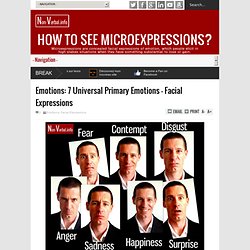
Each expression is recognizab... The seven universal primary emotions have unique characteristics. Each expression is recognizably different from the others. FEAREyes: They become bigger and rounder. The upper eyelids are raised, as in the expression of surprise, but the eyebrows are close and may even touch.Mouth: The lips are stretched horizontally. HAPPINESSEyes: The eyelids are tightened and wrinkles appear in the corners of the eyes, also known as crow's feet.
SURPRISEEyes: They are wide open and become rounded. DISGUSTNose: Wrinkles appear on and around the nose.Mouth: The upper lip rises and the lower lip can be off-axis. ANGEREyes: The eyes show an intense look, with or without white under the eyes. Bilinear Kernel Reduced Rank Regression for Facial Expression Synthesis. People Abstract Facial Expression Synthesis (FES) has been a flourishing area of research in the last few years driven by applications in character animation, computer games, video conferencing and human computer interaction.
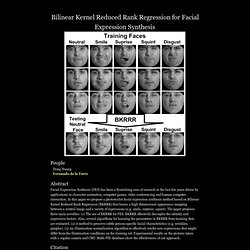
In this paper we propose a photorealist facial expression synthesis method based on Bilinear Kernel Reduced Rank Regression (BKRRR) that learns a high dimensional appearance mapping between a neutral image and a variety of expressions (e.g. smile, surprise, squint). The paper proposes three main novelties: (1) The use of BKRRR for FES. BKRRR effectively decouples the identity and expression factors. Citation Results Acknowledgements and Funding This research is supported by: Copyright notice.
Face_expressions.jpg. 25 Acts of Body Language to Avoid. Post written by: Marc Chernoff Email.
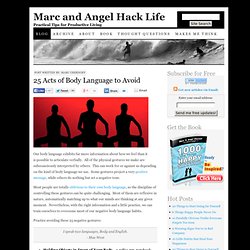
18 Ways to Improve Your Body Language. Think Twice: How the Gut's "Second Brain" Influences Mood and Well-Being. As Olympians go for the gold in Vancouver, even the steeliest are likely to experience that familiar feeling of "butterflies" in the stomach.
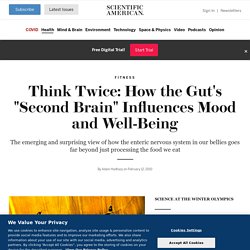
Underlying this sensation is an often-overlooked network of neurons lining our guts that is so extensive some scientists have nicknamed it our "second brain". A deeper understanding of this mass of neural tissue, filled with important neurotransmitters, is revealing that it does much more than merely handle digestion or inflict the occasional nervous pang. The little brain in our innards, in connection with the big one in our skulls, partly determines our mental state and plays key roles in certain diseases throughout the body. Nonverbal Communication: Improving Nonverbal Skills & Reading Body Language. What is nonverbal communication and body language?

When we interact with others, we continuously give and receive wordless signals. All of our nonverbal behaviors—the gestures we make, the way we sit, how fast or how loud we talk, how close we stand, how much eye contact we make—send strong messages. These messages don't stop when you stop speaking either. Even when you're silent, you're still communicating nonverbally. Oftentimes, what comes out of our mouths and what we communicate through our body language are two totally different things.
Why nonverbal communication matters The way you listen, look, move, and react tells the other person whether or not you care, if you’re being truthful, and how well you’re listening. If you want to become a better communicator, it’s important to become more sensitive not only to the body language and nonverbal cues of others, but also to your own. 9 Ways to Improve Your Posture. Steps Method 1 of 9: General Posture <img alt="Improve Your Posture Step 1.jpg" src=" width="670" height="503">1Identify good posture.

Good posture is nothing more than keeping your body in alignment. Body language broadcasts intentions. What does yours say? Learn to read flirting body language. The Ultimate Guide to Body Language. We spend our lives learning how to decode other people's nonverbal cues.

While we’re busy trying to decode their messages, they are also trying to decode ours. There are times when you want other people to know exactly how you’re feeling, especially when those feelings are both positive and reciprocated. This isn’t always easy to do, especially if you’re not a particularly emotive type of person. At other times, however, you definitely want to hide your inner feelings. To avoid emotional leakage, you may have to work doubly hard. Body language is, just that, the language of the body. Your Head Starting at the very top of your head is, of course, your scalp.
ASD Personality Traits and Basic Facial Expression Recognition Accuracy. 3rd Year project: Annie Murphy Supervised by Dr B.
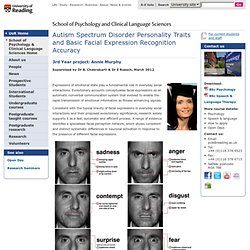
Chakrabarti & Dr E Roesch, March 2012 Expressions of emotional state play a fundamental role in everyday social interactions. Evolutionary accounts conceptualise facial expressions as an automatic nonverbal communication system that evolved to enable the rapid transmission of emotional information as fitness-enhancing signals. Consistent with the typical brevity of facial expressions in everyday social interactions and their proposed evolutionary significance, research widely supports it as a fast, automatic and efficient process.